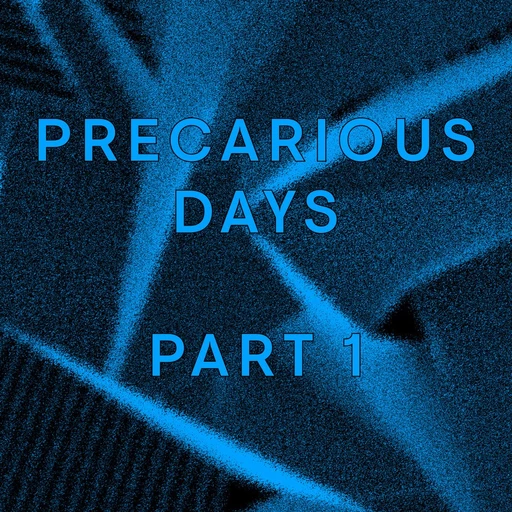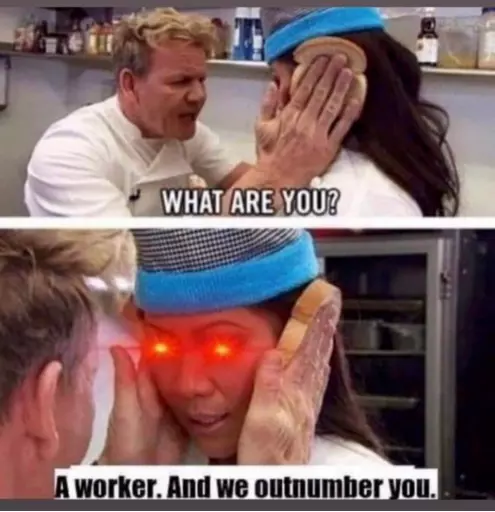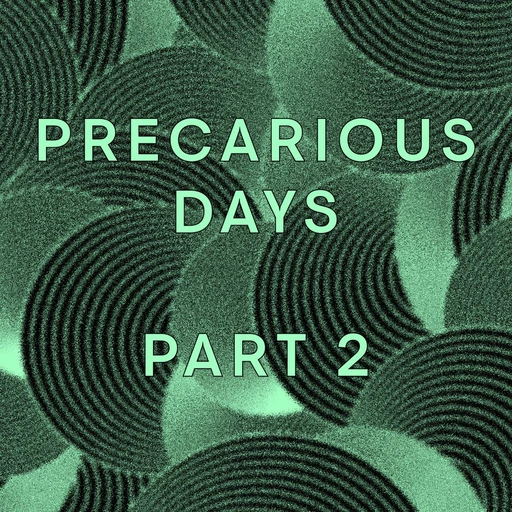
At the end of 2019, WALTER books, ArtEZ Studium Generale and Focus Filmtheater Arnhem, organised Precarious Nights, a series of evening film screenings, accompanied by talks, interviews and lectures. It was in no way an exhaustive discussion, but rather a start, an opening, to address the widely experienced insecurities of young art workers in relation to paid work and working conditions. By focusing on the idea of precarity, Precarious Nights tried to articulate how these insecurities are related to economic injustice, social inequality and political or institutional unaccountability.
In hindsight, the extensive scope of Precarious Nights seems somewhat baffling: to address the entangled aspects of numerous injustices (near and far) and the exploitative nature of capitalist systems of thought (never far away). Three months later, COVID19 laid bare all that shit. Needless to say, the pandemic has exacerbated labour conditions and has exposed the already precarious working conditions of many.
Student life in the meantime has relocated to the digital world, and so has mine, and I wish to continue our conversation here, as Precarious Nights turns into Precarious Days. Even though we are not near each other, I am curious to hear your own experiences, thoughts and references and hope that we can approach this as an opportunity to articulate our positions and forge links of solidarity.
In this first online contribution to a growing dossier, I am exploring the terms ‘precarious’ and ‘precarity’, reflecting on how the two interlink and wondering where the differences between them can become productive.
For the upcoming contributions, I continue to think through precarity and precariousness, and invite guests to contribute and to enter into conversation with me. If you want to reach out, please send an email to hopethisfindsyouwell@walterinarnhem.nl.[/i]
Student life in the meantime has relocated to the digital world, and so has mine, and I wish to continue our conversation here, as Precarious Nights turns into Precarious Days. Even though we are not near each other, I am curious to hear your own experiences, thoughts and references and hope that we can approach this as an opportunity to articulate our positions and forge links of solidarity.
In this first online contribution to a growing dossier, I am exploring the terms ‘precarious’ and ‘precarity’, reflecting on how the two interlink and wondering where the differences between them can become productive.
For the upcoming contributions, I continue to think through precarity and precariousness, and invite guests to contribute and to enter into conversation with me. If you want to reach out, please send an email to hopethisfindsyouwell@walterinarnhem.nl.[/i]
PART 1: precarious [ pri-kair-ee-uhs ]
Adjective ~ from Latin precarius: "obtained by asking or praying". A legal word, 1640s: “held through the favor of another”. Synonyms: uncertain, problematic, delicate, unhealthy, insecure, on thin ice, unsafe, unsure, ticklish, slippery, unsettled.
“Life without the promise of stability”, is how Anna Tsing defines precarity in her book The Mushroom At The End of The World. For Tsing, precarity is the norm of living in capitalist ruins, rather than the exception, as it is the “condition of being vulnerable to others”. This is echoed by Judith Butler, who in addition distinguishes between precariousness and precarity. Precariousness is defined as a common feature of all human life, an embodied vulnerability shared by all living beings, including the privileged. Political theorist Isabelle Lorey also makes this careful distinction: although we might all be precarious, or vulnerable, dependent on each other (hence precariousness as a connectedness that cannot be shaken off), precarity is a response to this common feature of life in various political, economic, legal and social forms of insecurity:
“Bodies remain precarious and need environments and institutions that provide security and support. (...) I call historically specific forms of insecurity—which are politically, economically, legally, and socially induced—precarity.”
The tension that ‘precarity’ brings to the conversation sits within the distribution of risk that comes with precariousness. The vulnerability that we all share is made riskier for some than for others; COVID19 has made us painfully aware of this. I am writing this from my ‘home office’, two words that were easily joined back in March, followed by a lockdown spent in relative comfort, at my kitchen table. But the risks of COVID19 were different for the delivery worker, the supermarket worker, the retail worker, the health care worker, and the migrant worker, whose work was in physical proximity to bodily risk. In contrast, the domestic worker was often excluded from their place of work, since the home became an exclusive territory to its inhabitants. Many domestic workers, often without any legal framework to fall back on, were cut off from work and income, from one day to the next.
Precarity acts as a hierarchy, as risks are distributed unequally while precariousness can be seen as an existential commonality, shared by all. To show how this difference can be productive, it is interesting here to look at Franco ‘Bifo’ Berardi’s definition of ‘precarious’. He defines it as:
“Precarious is [a] person who is able to know nothing about one’s own future and therefore is hung by the present and praises God to be rescued from the earthly hell (the term precarity derives from praying).”
Written in 2009 in his book Precarious Rhapsody, this definition resonates more truly with me today, because one of the quotidian features of my COVID reality is the absence of foresight. Although of course, one is never able to tell what the future holds, these days this seems to me a more deeply felt daily dread than an abstract truism.
In their book Theory of the Corral: Capitalism, Race, Fascism (title translated from the Dutch Theorie van de Kraal: Kapitalisme, Ras, Fascisme), authors Willem Schinkel and Rogier van Reekum (both guests during the first edition of Precarious Nights) emphasize on the first few pages of their book that they do not know how to live together, resonating Berardi’s unknowability of the future but approaching it as a productive starting point, as a way of rejecting the status quo and as a start to think otherwise. As Willem explained during the first edition of Precarious Nights:
“It's like we're on a train, that's continuously moving but we actually don't know why it's moving. We don't know why this is the only way and supposedly the most rational way of living together. And you know, another way of saying that is that we live in a neoliberal era where we are told that the way we live now is the only possible way to live. But we don't really know why, and it's interesting to just start by assuming that there is no good reason. And that then it's also not up to us to immediately provide an alternative.”
Rogier and Willem focus on the idea that we all don’t know how to live together, that the systems put in place can be questioned or even rejected. As they point out, there is a risk involved in this way of thinking, “everything is up for grabs”. In addition, when it comes to the precarious worker, it might be hard to see your situation as an opportunity to think otherwise, while you’re experiencing insecurity, anxiety or poverty on a daily basis. As Silvio Lorusso (guest at the third edition of Precarious Nights) states:
“[Franko] Bifo [Berardi] describes the inability to imagine one’s own future and the constant presence of anxiety. Clearly, this state of affair is not exceptional anymore. In order to change it, the precariat needs to formulate and articulate a series of demands, but how to do so when you can’t foresee your own life in a year from now? In other words, how to act against precarity if your time and thoughts are occupied by the state of being precarious? It seems that one needs stability in order to address precarity.”
This is where the collective seems to come in. Because the fragmented state of the precarious worker becomes even more fragmented if they are cut off from their peers, unable to make a collective demand or even just experience the relief and joy of support, both of giving and receiving it. Collective structures can provide some form of stability that is necessary to imagine possible futures.
And so workers are unionizing, and mutual aid networks have kicked into full gear and within this movement building, one can sense the immediate, activist response to a lack of organisation combined with the contours of new ways of organizing and new ways of thinking otherwise about what shared vulnerability means and could mean.
“Life without the promise of stability”, is how Anna Tsing defines precarity in her book The Mushroom At The End of The World. For Tsing, precarity is the norm of living in capitalist ruins, rather than the exception, as it is the “condition of being vulnerable to others”. This is echoed by Judith Butler, who in addition distinguishes between precariousness and precarity. Precariousness is defined as a common feature of all human life, an embodied vulnerability shared by all living beings, including the privileged. Political theorist Isabelle Lorey also makes this careful distinction: although we might all be precarious, or vulnerable, dependent on each other (hence precariousness as a connectedness that cannot be shaken off), precarity is a response to this common feature of life in various political, economic, legal and social forms of insecurity:
“Bodies remain precarious and need environments and institutions that provide security and support. (...) I call historically specific forms of insecurity—which are politically, economically, legally, and socially induced—precarity.”
The tension that ‘precarity’ brings to the conversation sits within the distribution of risk that comes with precariousness. The vulnerability that we all share is made riskier for some than for others; COVID19 has made us painfully aware of this. I am writing this from my ‘home office’, two words that were easily joined back in March, followed by a lockdown spent in relative comfort, at my kitchen table. But the risks of COVID19 were different for the delivery worker, the supermarket worker, the retail worker, the health care worker, and the migrant worker, whose work was in physical proximity to bodily risk. In contrast, the domestic worker was often excluded from their place of work, since the home became an exclusive territory to its inhabitants. Many domestic workers, often without any legal framework to fall back on, were cut off from work and income, from one day to the next.
Precarity acts as a hierarchy, as risks are distributed unequally while precariousness can be seen as an existential commonality, shared by all. To show how this difference can be productive, it is interesting here to look at Franco ‘Bifo’ Berardi’s definition of ‘precarious’. He defines it as:
“Precarious is [a] person who is able to know nothing about one’s own future and therefore is hung by the present and praises God to be rescued from the earthly hell (the term precarity derives from praying).”
Written in 2009 in his book Precarious Rhapsody, this definition resonates more truly with me today, because one of the quotidian features of my COVID reality is the absence of foresight. Although of course, one is never able to tell what the future holds, these days this seems to me a more deeply felt daily dread than an abstract truism.
In their book Theory of the Corral: Capitalism, Race, Fascism (title translated from the Dutch Theorie van de Kraal: Kapitalisme, Ras, Fascisme), authors Willem Schinkel and Rogier van Reekum (both guests during the first edition of Precarious Nights) emphasize on the first few pages of their book that they do not know how to live together, resonating Berardi’s unknowability of the future but approaching it as a productive starting point, as a way of rejecting the status quo and as a start to think otherwise. As Willem explained during the first edition of Precarious Nights:
“It's like we're on a train, that's continuously moving but we actually don't know why it's moving. We don't know why this is the only way and supposedly the most rational way of living together. And you know, another way of saying that is that we live in a neoliberal era where we are told that the way we live now is the only possible way to live. But we don't really know why, and it's interesting to just start by assuming that there is no good reason. And that then it's also not up to us to immediately provide an alternative.”
Rogier and Willem focus on the idea that we all don’t know how to live together, that the systems put in place can be questioned or even rejected. As they point out, there is a risk involved in this way of thinking, “everything is up for grabs”. In addition, when it comes to the precarious worker, it might be hard to see your situation as an opportunity to think otherwise, while you’re experiencing insecurity, anxiety or poverty on a daily basis. As Silvio Lorusso (guest at the third edition of Precarious Nights) states:
“[Franko] Bifo [Berardi] describes the inability to imagine one’s own future and the constant presence of anxiety. Clearly, this state of affair is not exceptional anymore. In order to change it, the precariat needs to formulate and articulate a series of demands, but how to do so when you can’t foresee your own life in a year from now? In other words, how to act against precarity if your time and thoughts are occupied by the state of being precarious? It seems that one needs stability in order to address precarity.”
This is where the collective seems to come in. Because the fragmented state of the precarious worker becomes even more fragmented if they are cut off from their peers, unable to make a collective demand or even just experience the relief and joy of support, both of giving and receiving it. Collective structures can provide some form of stability that is necessary to imagine possible futures.
And so workers are unionizing, and mutual aid networks have kicked into full gear and within this movement building, one can sense the immediate, activist response to a lack of organisation combined with the contours of new ways of organizing and new ways of thinking otherwise about what shared vulnerability means and could mean.


related content
blog Krista Jantowski – 14 dec. 2020
